Discussion Paper
TDP 2019/1
Proposed compliance framework - liquidity management
This version is no longer current. Please follow this link to view the current version. |
-
This discussion paper has been finalised. Our Response on the issue has been publishedThis document incorporates revisions made since original publication. View its history and amending notices, if applicable.
|
Purpose and status of this discussion paper
The purpose of this paper is to facilitate consultation between the Australian Taxation Office (ATO) and the community as part of the process of developing advice on the application of the [tax/superannuation] law. This paper is prepared solely for the purpose of obtaining comments from interested parties. All views in this paper are therefore preliminary in nature and should not be taken as representing either an ATO view or that the ATO will take a particular view. This paper is not a publication that has been approved to allow you to rely on it for any purpose and is not intended to provide you with advice or guidance, nor does it set out the ATO's general administrative practice. Therefore, this paper does not provide protection from primary tax, penalties or interest for any taxpayer that purports to rely on any views expressed in it. |
What this document is about
1. ATO ID 2012/90, ATO ID 2012/91 and ATO ID 2012/92 address whether intra-entity liquidity charges are deductible for the purposes of determining the profits attributable to the foreign bank's Australian permanent establishment. Those ATO IDs state that liquidity charges are not deductible to the Australian permanent establishment. Whilst those ATO IDs were based on the Commissioner's review of one particular model for managing liquidity, the Commissioner's view is that the principles outlined in those ATO IDs apply to intra-entity liquidity charges generally.
2. Whilst the Commissioner acknowledges that liquidity charges may be deductible to an Australian permanent establishment where the charge represents a reasonable allocation of actual third party expenses, or a reasonable proxy for such expenses, the Commissioner has yet to review a liquidity management model under which the liquidity charges satisfy the requirements for deductibility.
3. However, in response to industry requests for further guidance on this issue, this document outlines the limited circumstances in which the cost of liquidity management, and in particular funding costs associated with managing liquidity, may be deductible to the Australian operations (head office or permanent establishment) of multinational banks. It sets out the Commissioner's expectations regarding the factors that must be present, particularly in terms of transparency and documentation, before a deduction for liquidity costs may be claimed.
4. In the event that liquidity costs are prima facie deductible, it is also necessary to consider whether the liquidity cost allocating mechanism can be regarded as an appropriate proxy for the purposes of allocating or attributing a bank's profits[1] for the purposes of Subdivision 815-C of the Income Tax Assessment Act 1997 (ITAA 1997) and any relevant double tax agreement(s)(DTA), or whether further adjustments are required to reflect an appropriate arm's length amount.
5. The Commissioner's views on the operation of Australia's permanent establishment attribution rules and the application of those attribution rules to certain funding activities of banks are set out in detail in Taxation Rulings TR 2001/11 Income tax: international transfer pricing - operation of Australia's permanent establishment attribution rules and TR 2005/11 Income tax: branch funding for multinational banks respectively. This document outlines the circumstances in which the arm's length principles detailed in those taxation rulings may apply to the allocation of the cost of liquidity management, and in particular funding costs, to the Australian operations (head office or permanent establishment) of multinational banks.
6. This document provides indicative guidance on the Commissioner's compliance expectations for banks seeking to rely on it. It considers a number of scenarios involving centralised and decentralised liquidity management frameworks in order to illustrate the principles that will govern the application of this compliance approach.
7. For the purposes of this document, 'liquidity charges' are credit or debit amounts allocated between different parts of a bank that purport to be an allocation of costs incurred in the management of that bank's liquidity risk. This could be either between the head office of a bank and a permanent establishment (PE), or between two branches of the bank.
Scope of this document
8. This document addresses scenarios involving Australian resident banks with foreign branches, and those involving banks that are not Australian residents (foreign banks) that carry on business in Australia through PEs.
9. For the purposes of this document, a bank is a body corporate that has been granted a banking licence to operate a banking business in Australia as an 'authorised deposit-taking institution' under the Banking Act 1959.
10. This document does not address liquidity charges between separate legal entities, for example, between a company and its subsidiary, or between subsidiaries within the same wholly owned group. The tax treatment of such inter-entity charges would be assessed on a case by case basis and would turn on the general rules of deductibility as well as on the transfer pricing rules in Subdivision 815-B of the ITAA 1997 and the relevant DTAs.
Background
Liquidity risk management
11. Liquidity risk is one of the key risks faced by banks. For the purposes of this guidance, liquidity risk may be defined as the risk that, due to a deficit of liquidity, a bank becomes either unable to meet all of its payment obligations as they fall due, or is only able to meet these obligations at excessive costs (for example, through forced asset sales in a depressed market).
12. Liquidity risk management may encompass a broad range of activities, which largely fall within two broad dimensions.
13. Firstly, a bank may establish and maintain a 'liquidity reserve' of cash and high quality liquid securities (such as government bonds) surplus to that required to meet its immediate obligations. This surplus would act as a buffer to ensure that the bank could continue to meet its liabilities in the event of a liquidity stress scenario. The bank would typically derive less income from holding the assets in the liquidity reserve than it costs to fund their purchase, and so would generally - but not always - derive a net loss (also known as a 'negative carry') from its liquidity reserves.
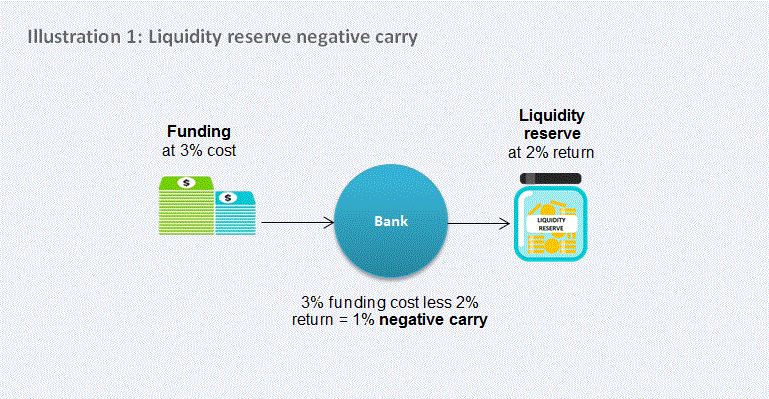
14. Secondly, a bank's level of liquidity risk is influenced by its funding and asset profile. A bank will have a 'tenor mismatch' when it lends at longer (more profitable) tenors while borrowing at shorter (less expensive) tenors. The greater the tenor mismatch, the more vulnerable the bank becomes to tightening credit conditions. This risk may be managed by ensuring that the bank has a spread of funding in different maturities, including adequate term funding to support its income-generating assets. This comes at a cost because, all other factors being equal, long term funding is more expensive than short term funding.
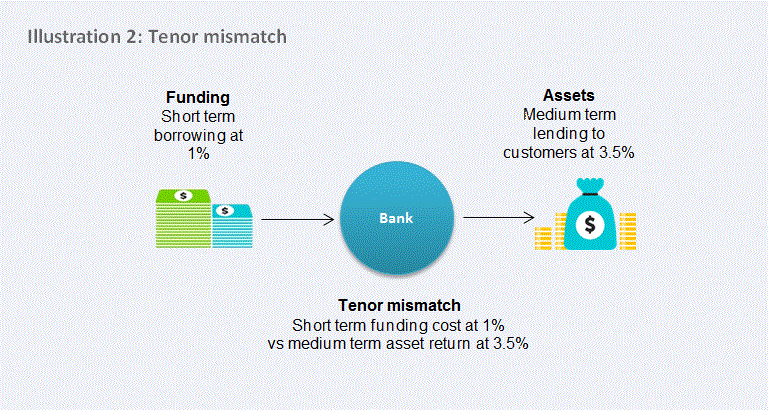
Regulatory framework
15. Banking regulators around the world have recognised the significance of liquidity risk and the importance of managing liquidity risk to the systemic health of domestic and international banking systems. As such, many have implemented compulsory detailed standards and requirements for banks to meet in managing liquidity.
16. For example, the Basel III regulatory framework requires banks to maintain a sufficient buffer of high quality liquid assets to survive a significant stress scenario for 30 days, and a one-year net stable funding ratio to ensure sustainable asset and liability term structures.[2]
17. In the Australian context, banks are required to comply with the Australian Prudential Regulatory Authority (APRA) Prudential Standard APS 210 titled 'Liquidity' (January 2014). That standard requires banks to hold enough liquidity to survive a severe liquidity stress scenario for 30 days,[3] and to survive a 'name crisis' scenario for five business days.[4]
18. While the regulatory framework that governs the bank's business would strongly influence its liquidity management strategy, the ATO does not consider the operation of any such regulatory framework to limit the application of the relevant taxation principles. That is, to the extent that liquidity management costs are appropriately allocated to a bank's Australian business, the amount of the taxable increase or decrease in the profit attributed to that business is not determined by the extent to which the bank's liquidity management was required by regulation.
Models of liquidity management
19. The ATO has encountered a range of models adopted by multinational banks to address these dimensions of liquidity risk management.
20. At one end of the spectrum lies a purely decentralised model, whereby each of a bank's operating locations is responsible for managing its own liquidity. In this model, each part of the bank would maintain its own liquidity reserve separate to the rest of the entity, and each would ensure that it has the appropriate funding profile to support its own income producing assets.
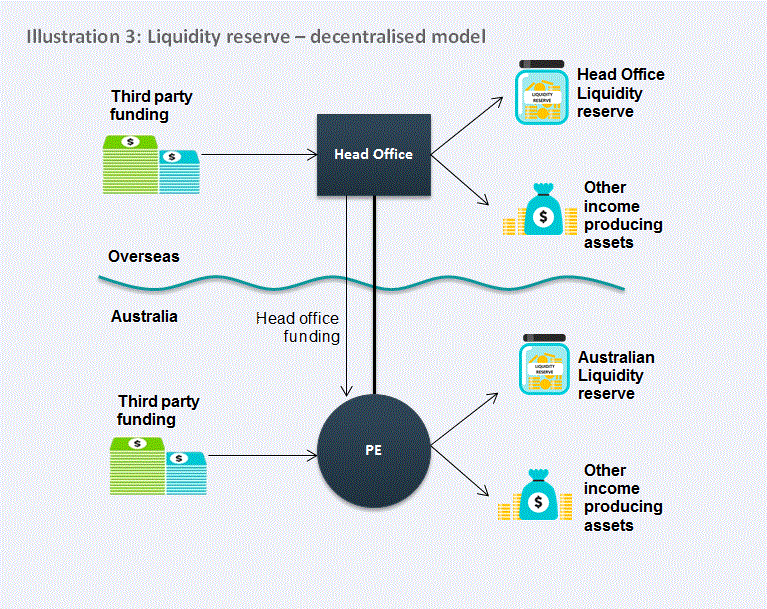
- •
- The Australian PE maintains its own liquidity reserve, sufficient to support its balance sheet.
- •
- The Australian PE is funded with a combination of third party and parent funding to support its own liquid and other income producing assets.
- •
- The liquidity reserve is solely managed in Australia with the liquid assets held and available for use solely in Australia, and all costs related to the management of the reserve are incurred in Australia.
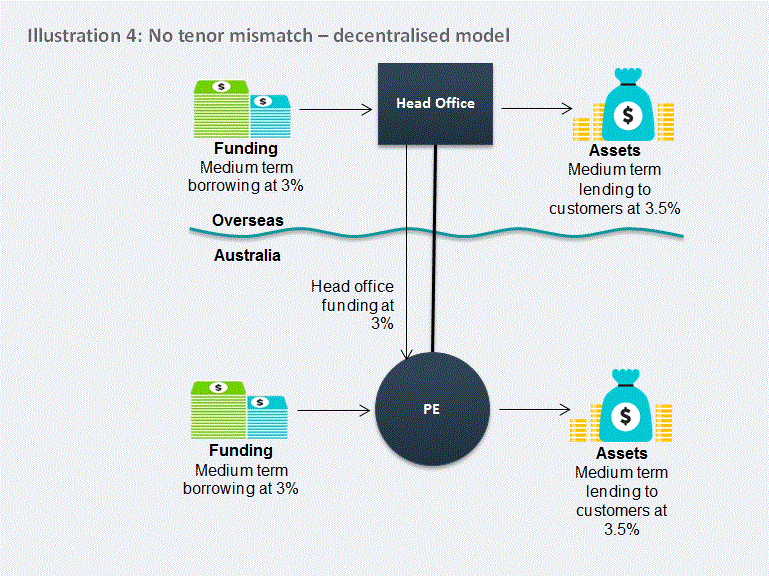
- •
- The Australian PE is funded with a combination of third party and parent funding to support its income generating assets.
- •
- In this example, the Australian PE has obtained medium term funding (giving rise to a 3% funding cost) to support their medium term assets (generating a 3.5% return).
- •
- There is no tenor mismatch.
21. At the other end of the spectrum, a bank may adopt a purely centralised model, in which it manages its liquidity reserve and funding profile at a global level. That is, the bank (often through its group treasury function) would maintain a global liquidity reserve and ensure adequate term funding within the legal entity to support all of the operations of the branches and head office.
22. Under a centralised model a certain portion of the reserve may be designated as being maintained solely for the benefit of particular operations of the bank (i.e. 'ring fenced').
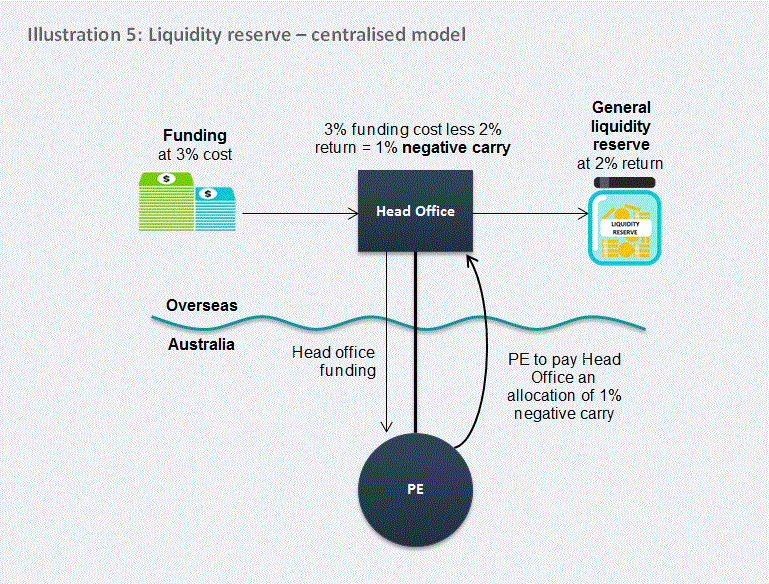
- •
- The Head Office maintains a general liquidity reserve to support its global operations.
- •
- The Head Office derives a loss (negative carry) as the cost of funding the reserve is greater than the income returned by the liquid assets.
- •
- The Head Office charges the PE an allocation of the negative carry on the basis that the Australian PE also benefits from the reserve that is maintained by the Head Office.
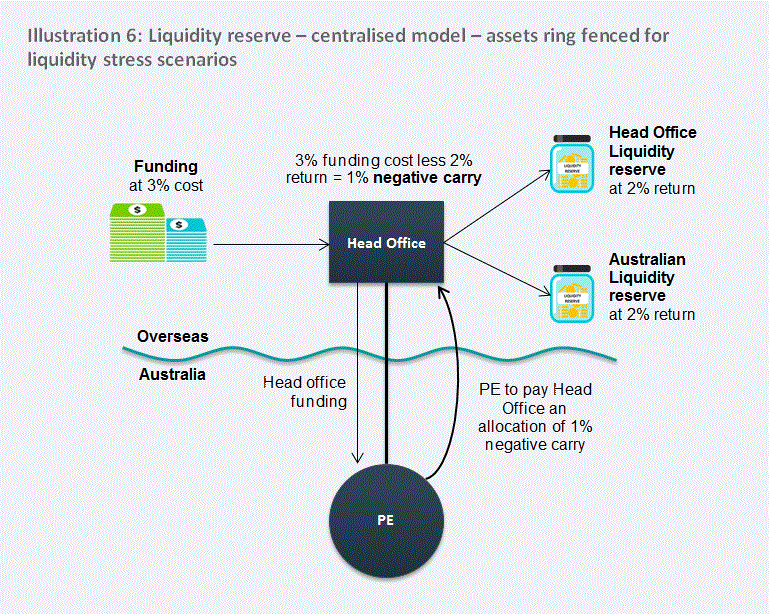
- •
- The Head Office maintains the liquidity reserve to support its global operations. A particular portion of the reserve has been ring fenced and set aside for the sole use of the Australian business in the event of a liquidity stress scenario for the Australian business.
- •
- The Head Office derives a loss (negative carry) as the cost of funding the reserve is greater than the income returned by the liquid assets.
- •
- The Head Office charges the PE an allocation of the negative carry on the basis that a particular portion of the reserve is ring fenced and maintained solely for the benefit of the Australian PE.
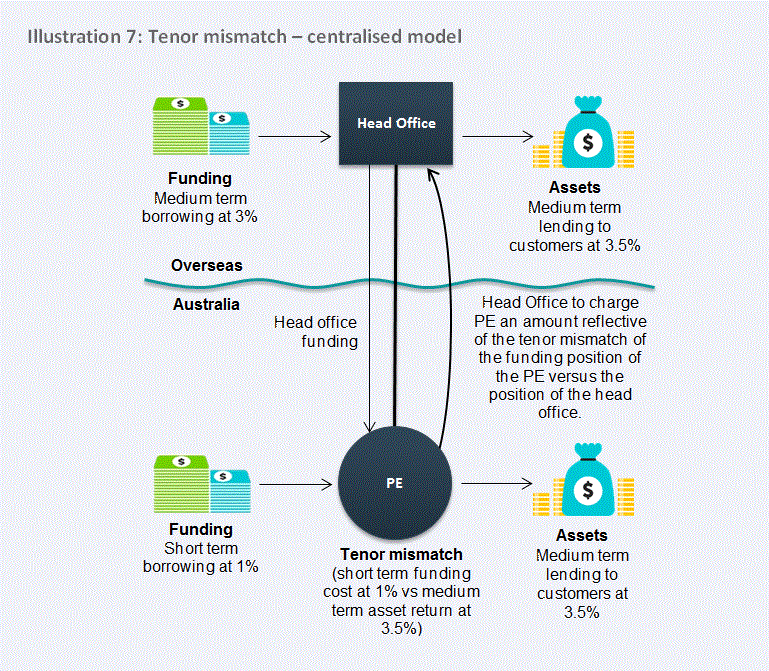
- •
- The Head Office and the Australian PE have a similar medium term asset profile.
- •
- The Australian PE has a tenor mismatch arising from taking a short term position on its funding (giving rise to a short term funding cost at 1%) compared to its medium term assets (generating a 3.5% return).
- •
- The Head Office has obtained medium term funding (giving rise to a 3% funding cost) to support its medium term assets (generating a 3.5% return).
- •
- The Head Office charges the Australian PE an amount reflective of the tenor mismatch of the funding position of the PE versus the position of the head office.
23. A bank's allocation mechanism for liquidity costs is both a part of, and shaped by, its liquidity management model. For example, in a decentralised model, liquidity costs would be borne by the jurisdiction in which they were incurred, as it is that jurisdiction that gains the benefit from those costs. By contrast, in a centralised model, costs will be incurred in some jurisdictions to satisfy the liquidity needs in others. Banks may then seek to allocate the relevant costs according to an allocation key.
24. Unless the context suggests otherwise, the phrase 'liquidity framework' is used in this document to refer to a bank's liquidity management framework in its entirety, including the cost allocation mechanism.
Liquidity costs
25. Funding costs would be expected to account for most of the costs incurred by a bank to manage liquidity. These would be the costs of funding the acquisition of the assets in its liquidity reserves, and the costs of servicing term funding to manage its tenor mismatch.
26. However, the Commissioner recognises that a bank may incur other costs in managing its liquidity and liquidity risk. These other costs may include, to the extent that they are connected to liquidity management:
- (a)
- staffing costs
- (b)
- accommodation costs
- (c)
- technology costs; and
- (d)
- other overheads.
27. The proposed guidance is intended to apply only to liquidity costs that purport to be an allocation of the funding costs associated with managing liquidity risk and does not consider the application of the principles to non-funding costs. However, we would expect that a consideration of the income tax and attribution treatment of non-funding costs would proceed along similar lines to that of funding costs.
Allocation of liquidity costs
28. In a purely decentralised liquidity management framework, liquidity costs would generally be incurred by the businesses that derive the benefit from incurring them. In these models, the scope to reallocate costs to other parts of the bank would be negligible.
29. By contrast, models that have centralised features would generally see one or more parts of the bank hold and manage liquid assets for both themselves and on behalf of other parts of the bank. This results in those parts of the bank (being net 'providers' of liquidity) holding liquid assets in excess of that needed to support their own businesses, with the bank then potentially seeking to allocate costs incurred to other parts of the bank that are supported by the expenditure (the net 'users' of liquidity).
30. The Commissioner's understanding of industry practice is that the liquidity framework and charging mechanisms do not necessarily exist in a vacuum. That is, a bank seeking to pass on funding costs associated with liquidity management to another part of the bank will not always do so as a standalone internal charge. Rather, a bank may seek to pass on those costs alongside and in conjunction with the bank's broader profit attribution mechanisms. For example, a bank may adjust the pricing on an internal loan or an internal derivative (as the case may be). Any of these mechanisms do not necessarily operate merely as the purported allocation of liquidity costs, but rather as adjustments to the allocation of profit (i.e. the income and expenses) by the bank to each location. These adjustments may seek to account for the liquidity risk and liquidity profile of the business or businesses being carried out in that location while also allocating interest income or expense from general funding, or gains and losses related to derivatives. In particular, the allocation of funding costs associated with liquid assets can be closely related to the allocation of funding and risk management costs more generally.
31. The Commissioner's current understanding of industry practice in terms of mechanisms used by banks that seek to pass on costs include:
- (a)
- a liquidity charge - a debit or credit charge applied to each part of the bank to adjust each location's share of the overall liquidity costs via some allocation key;
- (b)
- an adjustment to the rates used to price internal funds transfers; and
- (c)
- adjustments to the pricing of internal derivatives.
32. In this document, the term 'liquidity adjustment' refers to any such mechanism that purports to allocate liquidity management costs. Irrespective of the mechanism used, the amount referable to the liquidity adjustment must both satisfy the requirements for deductibility and the quantum must also reflect an appropriate arm's length amount before it can be taken into account for the purpose of attributing the bank's profits under Division 815-C of the ITAA 1997 or the relevant DTA.
Compliance framework
General principles governing the deductibility of liquidity costs
33. For a branch to be able to deduct an amount purported to relate to funding costs associated with liquidity management, the amount must satisfy the ordinary requirements for deductibility under section 8-1 of the ITAA 1997. In particular, the amount must be a loss or outgoing incurred by the bank in gaining or producing its assessable income, or in carrying on a business for the purpose of gaining or producing assessable income.
Intra-entity charges are neither deductible nor assessable
34. The Commissioner's views on the operation of Australia's permanent establishment attribution rules and the application of those attribution rules to certain funding activities of banks are set out in detail in Taxation Rulings TR 2001/11 Income tax: international transfer pricing - operation of Australia's permanent establishment attribution rules and TR 2005/11 Income tax: branch funding for multinational banks respectively.
35. As explained in those rulings, Australia has adopted the 'relevant business activity' (RBA) approach to profit attribution, which requires the allocation of actual third party income and expenses. Under this approach, intra-entity dealings, for example as between the head office and a branch, are neither attributable nor deductible. This approach is consistent with the decision in Max Factor & Co v. Federal Commissioner of Taxation (1984) 84 ATC 4060 and the view expressed in ATO Interpretative Decision ATO ID 2012/90.
36. However, the Commissioner recognises that intra-branch dealings such as liquidity adjustments may, in the limited circumstances outlined in this document, represent a reasonable allocation of actual third party income and expenses incurred by the bank, or be a reasonable proxy for such amounts.
37. For example, where a bank uses debit and credit liquidity charges to allocate liquidity costs among its branches, the charge itself will never be deductible nor assessable to an Australian branch. However, an amount referable to the charge may represent an allocation of actual third party expenses or an amount of income (as the case may be), where the charging mechanism provides a reasonable allocation of those actual third party amounts or a reasonable proxy for those amounts.
Treatment of net amounts
38. A 'net amount' cannot be a loss or outgoing incurred under section 8-1 of the ITAA 1997 unless, if the net amount were instead a profit, such net profit would be assessable income for the purpose of applying section 6-5 of the ITAA 1997. Rather, it is each constituent income and expense component of the net amount that is the relevant amount for the purposes of section 6-5 or section 8-1, as the case may be. This approach is consistent with the view expressed in ATO Interpretative Decision ATO ID 2012/91.
39. In the context of liquidity, this principle is relevant in considering the income tax treatment of liquidity reserve costs (which are often stated as a 'net loss' or a 'negative carry'). From an interpretative perspective, the Commissioner's view is that the net gain or loss itself will never be assessable or deductible. Rather, the relevant enquiry is whether each constituent item of income and expense is assessable or deductible, as the case may be.
40. However, the Commissioner may in some circumstances treat a net gain or loss as a reasonable proxy for the appropriate allocation of income and expenses arising from the liquidity reserve. In this regard, the Commissioner notes that it is the nature of high quality liquid assets that the return on those assets would usually be less than the cost incurred to fund them. To the extent that those costs were always expected to exceed any return on the assets, the Commissioner acknowledges that the incurring of those costs could only be explained by reference to an objective other than the direct derivation of income from the assets themselves.
41. Where the use of the net gain or loss arising from a liquidity reserve results in materially the same outcome as the allocation of individual income or expense amounts according to the above analysis, the Commissioner will accept the use of the net amount.
Transparency framework and 'red flag' approach
42. The Commissioner will use a framework based on transparency and documentation to guide compliance activity in respect of a bank's liquidity management framework and associated charges.
43. In compliance work undertaken to date, the Commissioner has considered a number of scenarios involving the management of liquidity risk by banks in the ordinary course of their business. These particular scenarios have exhibited a number of features or elements which we will refer to as 'red flags'. The presence of any of these 'red flags' in a liquidity management framework would indicate that the resulting liquidity adjustments (either by themselves or in conjunction with the other parts of the bank's profit attribution framework) are at high risk of not being a reasonable allocation of, or a reasonable proxy for, actual income and expenses associated with liquidity management.
44. Where a liquidity framework displays one or more red flags, then the Commissioner will require a significant level of analysis and documentary evidence to be satisfied that the resulting liquidity charges are a reasonable proxy for assessable or deductible amounts. Given the fungible nature of liquidity and liquid assets, the presence of one or more red flags means that the liquidity charges are unlikely to be deductible.
45. A liquidity framework is in the 'green zone' when it demonstrates none of the red flags. For green zone scenarios, the Commissioner will accept that a deduction calculated by reference to the intra-entity liquidity charge may be prima facie allowable, however this will still need to be supported by appropriate analysis and documentary evidence.
46. The Commissioner has identified a number of risk areas that are specifically relevant to the question of whether a liquidity charge, or an amount equal to a liquidity charge, is deductible to the Australian operations of a multinational bank (head office or permanent establishment). These principles form the interpretative basis that shapes the Commissioner's compliance approach to liquidity charges, and is considered in the context of a number of illustrative scenarios below.
Profit attribution
47. In the event that a liquidity charge is found to be prima facie deductible, it is then necessary to consider a number of overarching principles that govern branch attribution generally.
48. The allocation of income and expenses to a branch of a bank is also subject to Australia's permanent establishment (PE) attribution rules and transfer pricing rules as expressed in the relevant double tax agreements (DTAs) and Subdivision 815-C of the ITAA 1997.
49. The Commissioner accepts that, in appropriate circumstances, a liquidity adjustment that is found to be prima facie deductible may be used as a proxy for the attribution of actual third party income and expenses for the purposes of attributing the bank's profits under Division 815-C of the ITAA 1997 or the relevant DTA.
50. The attribution of those amounts involves a two-step process as prescribed in Taxation Rulings TR 2001/11 and TR 2005/11. This requires banks to undertake:
- (a)
- a functional analysis, considering functions performed, assets used and risks assumed by each business activity that is part of the bank's global structure to determine the functional profile associated with that activity, and
- (b)
- a comparability analysis to determine an arm's length return for the functions, assets and risks attributed to each part of the bank based on that functional profile.
51. Where a liquidity adjustment can be used as a reasonable allocation of, or a reasonable proxy for, actual third party costs under this document, and the quantum of the charge can be shown to satisfy the relevant arm's length transfer pricing principles, then the Commissioner will generally accept a lower level of analysis and documentary evidence to support the bank's treatment of the liquidity charge as an assessable or deductible adjustment (as the case may be) to its Australian taxable income.
Risk areas
52. The ATO has identified a number of 'red flags' arising in the various models adopted by multinational banks for their respective liquidity frameworks. These risks are focused on four key risk areas:
- •
- Use of internal inputs
- •
- Unreasonable quantification
- •
- Lack of transparency
- •
- Use of assets for purposes other than liquidity
Risk area 1: Internal inputs
53. As a threshold test for deductibility, section 8-1 of the ITAA 1997 requires an actual loss or outgoing to be incurred. That is, a bank may only deduct an actual expense that it has incurred vis-à-vis another legal entity.
54. A liquidity adjustment is therefore not deductible to the extent that it represents internal inputs. These may include discounts or premiums applied to the liquidity charge to influence managerial behaviour, or to reflect managerial sentiment, strategy or forecasts. For example, the adjustment may price and pass on opportunity costs.
55. A liquidity adjustment cannot be deductible to the extent that it is not referable to actual transactions which the bank has entered into. For this reason, the presence of any internal inputs in a liquidity framework would raise considerable doubt that a liquidity adjustment would be deductible.
Example 1: Green zone - no management inputs
For Co is a foreign resident bank that operates in Australia via a branch. Head office, located in a foreign jurisdiction, is responsible for the management of liquidity risk and maintains a liquidity reserve for this purpose. For Co's average cost of external funding is 4%.
The cost of holding the liquidity reserve is calculated as if the reserve assets were funded at the average cost of external funds, being 4%. There are no management adjustments applied to determine this funding cost.
A portion of the negative carry on the reserve is allocated to the Australian branch as a 'liquidity charge' based on the relative contribution of the branch operations to the liquidity risk of For Co.
Example 2: Red flag - management inputs
For Co is a foreign resident bank that operates in Australia via a branch. Head office, located in a foreign jurisdiction, is responsible for the management of liquidity risk and maintains a liquidity reserve for this purpose.
For management accounting purposes, the cost of holding the reserve assets is priced using a methodology that adjusts the external cost of funds to provide incentives for the managers of business units to acquire assets in particular tenors or currencies.
A portion of the negative carry on the reserve is allocated to the Australian branch based on the relative contribution of the branch operations to the liquidity risk of For Co. It is not clear how the quantum of the charge has been influenced by the internal inputs applied to work out the funding cost, or how the adjusted cost of funds relates to the actual external cost of funds.
Risk area 2: Quantification of costs
56. Section 8-1 of the ITAA 1997 requires that a cost or outgoing be incurred. The liquidity charge should therefore be comprised of inputs that are referable directly to external costs, both in nature and in quantum.
57. However, the Commissioner recognises that in a complex banking business it is not always possible or feasible to quantify all costs directly, and that some costs can only be quantified by estimation or modelling.
58. The use of modelled inputs within a liquidity framework reduces the transparency of the liquidity adjustment and raises doubt as to whether the adjustment may be used as a proxy for actual costs and outgoings, unless:
- (a)
- it is possible to establish that each of the inputs being modelled is a real third party expense incurred by the bank;
- (b)
- inputs are modelled only where direct costing of those inputs is unfeasible; and
- (c)
- the method used to model each modelled input is reasonable, transparent, verifiable and referable to objective factors.
Example 3: Green zone - modelled costs
For Co is a foreign resident bank that operates in Australia via a branch. Head office, located in a foreign jurisdiction, is responsible for the management of liquidity risk and maintains a liquidity reserve for this purpose.
For Co models its average cost of funds taking into account the cost of deposits modelled on assumptions drawn from actuarial analysis of depositor behaviour, which is regularly reviewed and updated. This modelled cost of funds is used to determine the cost of holding the reserve assets and calculating the negative carry on the reserve.
Example 4: Red flag - hypothetical funding construct
For Co is a foreign resident bank that operates in Australia via a branch. Head office, located in a foreign jurisdiction, is responsible for the management of liquidity risk and maintains a liquidity reserve for this purpose.
For the purpose of determining the cost of funds used to hold the reserves, For Co models a cost of funds based on a hypothetical funding strategy using borrowings at a longer tenor. This hypothetical cost of funds is then used to calculate the negative carry on the reserve.
There is no relation between the actual average cost of the external funding of For Co and the hypothetical basis on which cost of funds used to determine the negative carry is calculated.
Risk area 3: Transparency
59. The proper application of the RBA approach to profit attribution and the use of reasonable proxies depend on the ability to 'see through' a charge to its constituent inputs to determine whether they meet the requirements for inclusion in taxable income (either as items of assessable income or as allowable deductions). This analysis is not possible where the framework does not allow the ATO to:
- (a)
- identify all of the inputs; or
- (b)
- identify how each input is quantified.
60. Where this is the case, then the Commissioner will not accept the liquidity charges to be a reasonable allocation of or a reasonable proxy for the actual third party income and expenses, and therefore cannot be used in determining an appropriate adjustment of the bank's profit allocation to reflect the attribution of liquidity risks and costs. Any claim for a deduction for liquidity costs in its Australian business or businesses would need to be founded upon the general principles of deductibility and profit attribution discussed above.
Example 5: Red flag - lack of transparency
For Co is a foreign resident bank that operates in Australia via a branch. Head office, located in a foreign jurisdiction, is responsible for the management of liquidity risk. For Co has a general policy that the cost associated with liquidity risk management will be charged to business units.
For the purpose of calculating the taxable income of the Australian branch, For Co deducts an amount described in the management accounts as a 'liquidity charge'. However there is only limited evidence explaining how the charge was quantified, such as worksheets showing the calculation of the costs incurred by head office, or the methodology that was used to allocate a portion of that amount to the Australian branch.
Risk area 4: Use of assets for purposes other than liquidity
61. The Commissioner recognises that regulatory and commercial drivers may require a bank to acquire and maintain reserves of high quality liquid assets to support its business operations in the event of a liquidity stress scenario.
62. However, this must be balanced against the fact that liquid assets are, by their very nature, readily capable of being realised to meet any liabilities that may arise.
63. On balance, the presumption must be that those assets, and the costs incurred to acquire and hold them, are attributable to the location in which they are most readily available for use. The fact that the size of the liquidity reserve is determined by reference to the global business (including the business carried on in Australia) would, without more evidence, be insufficient to disturb that presumption.
64. Therefore, the Commissioner would view as a 'red flag' any liquidity framework that purports to allocate costs relating to liquidity reserves where there is nothing to disturb the presumption that assets in that reserve are held to support the bank's business in the jurisdiction in which the assets are held or managed. Factors further supporting this presumption would include, but are not limited to:
- (a)
- a liquidity reserve whose assets have been used to a material extent to meet liabilities outside of a liquidity stress scenario;
- (b)
- a liquidity reserve where there is nothing in the relevant policies of the bank that would restrict or limit the use of the liquidity reserve assets to meet the day-to-day liabilities of the bank;
- (c)
- a liquidity reserve which is not a pool of liquid assets specifically acquired for liquidity management, but is merely a notional aggregation of the liquid assets that happen to be on the bank's global balance sheet at any given time; or
- (d)
- due to practical or legal restraints any funds realised on the sale of assets would not be capable of being applied to satisfy liabilities of the bank outside of the jurisdiction in which the liquidity reserve is held.
65. Where a liquidity reserve is centrally held and managed on the basis that a portion of the assets are designated as being maintained solely for the benefit of particular operations of the bank (i.e. 'ring fenced') the circumstances are less likely to exhibit these concerns. However, the bank will need to satisfy the Commissioner that these assets are sufficiently 'ring-fenced' such that they are available for use solely by the Australian branch.
Example 6: Red flag - Reserve assets used as general reserve
For Co is a foreign resident bank that operates in Australia via a branch. Head office, located in a foreign jurisdiction, is responsible for the management of liquidity risk. For Co maintains a reserve of highly liquid assets. This reserve is available to fund all kind of future net cash outflows of the bank, including its day to day operational liabilities.
For the purpose of calculating the taxable income of the Australian branch, For Co deducts an amount described in the management accounts as a 'liquidity charge' referrable to the cost of maintaining the general head office reserve. However, For Co is unable to satisfy the Commissioner that the assets are not maintained and available for use for the benefit of the head office.
Feedback
66. The ATO welcomes feedback on the matters raised in this document. The ATO is particularly interested on views regarding the proposed approach, and in examples of liquidity management frameworks that may fall within the 'green zone'.
67. Feedback should be addressed to: [Please refer to cover letter]
Appendix 1: Summary of 'Red Flags'
This table summarises the areas of concern that are explained in more detail in the Discussion Paper.
| Item No. | 'Red flag' | Risk Area | Details |
|---|---|---|---|
| 1. | Management inputs | Internal Inputs | The cost of funds modified by management to provide incentives to undertake certain types of business. This modified cost of funds is used to determine the cost of holding the liquidity reserve or in the calculation of other charges applied for liquidity management purposes. |
| 2. | Hypothetical funding construct | Quantification of costs | The cost of funds used to determine liquidity charges is based on a hypothetical construct that has no relation with the actual funding of the entity and the real external cost of those funds. |
| 3. | Modelled costs | Quantification of costs | Costs that are capable of direct calculation have been modelled and used in calculating liquidity charges. |
| 4. | No basis of calculation | Transparency | No documentation evidencing how the liquidity charge was quantified or the basis for its application to the Australian branch. |
| 5. | General reserve | Assets used for other purposes | The liquidity reserve is available to fund all kinds of future net cash outflows of the bank, including its day to day operational liabilities. |
| 6. | Notional reserve | Assets used for other purposes | Liquidity reserve which is not a pool of liquid assets specifically acquired for liquidity management, but is merely a notional aggregation of the liquid assets that happen to be on the bank's global balance sheet at any given time. |
| 7. | Funds cannot be used outside of home jurisdiction | Assets used for other purposes | Due to practical or legal restraints any funds realised on the sale of reserve assets would not be capable of being applied to satisfy liabilities of the bank outside of the jurisdiction in which the liquidity reserve is held. |
Footnotes
Section 815-225(3) of the ITAA 1997 provides that actual expenditure includes losses and outgoings and actual income includes any amount included in assessable income.
See Basel Committee on Banking Supervision, 'Basel III: The Liquidity Coverage Ratio and liquidity risk monitoring tools' (January 2013) and 'Basel III: the net stable funding ratio' (October 2014).
Paragraphs [1] to [5] of Attachment A to APS 210.
Paragraph [2] of Attachment B to APS 210.
References
File
Legislative References:
ITAA 1997
ITAA 1997 6-5
ITAA 1997 8-1
ITAA 1997 Subdiv 815-B
ITAA 1997 Subdiv 815-C
ITAA 1997 815-225(3)
Banking Act 1959
Case References:
Max Factor & Co v Federal Commissioner of Taxation
84 ATC 4060
15 ATR 231
Other References:
ATO ID 2012/90
ATO ID 2012/91
ATO ID 2012/92
TR 2001/11
TR 2005/11
APRA, 2014, Prudential Standard APS 210 Liquidity
Bank of International Settlements, 2013, Basel III: The Liquidity Coverage Ratio and liquidity risk monitoring tools, Basel Committee on Banking Supervision, Basel.
Bank of International Settlements, 2014, Basel III: the net stable funding ratio, Basel Committee on Banking Supervision, Basel.
| Date: | Version: | Change: | |
| You are here | 6 April 2018 | Original discussion paper | |
| 30 July 2019 | Response |
